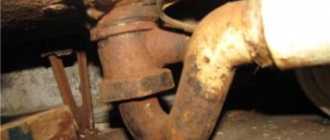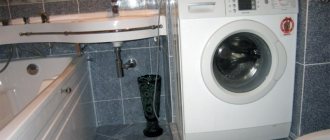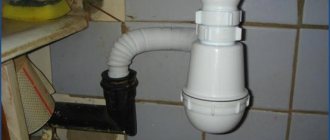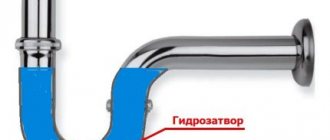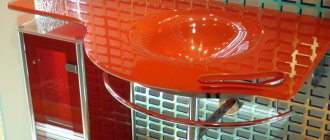Self-installation of a sink is necessarily accompanied by the procedure for purchasing a new siphon, its assembly and installation. A drain siphon for a washbasin is a structure through which liquid passes, and thanks to the water plug, sewer gases are blocked.
The selection criteria and subsequent assembly of this plumbing fixture are simple, but following all the rules can protect against further leaks, which will ensure uninterrupted operation of the drain.
In this material we will talk about the design and types of drain systems for washbasins, as well as what rules should be followed when choosing.
Structure
A siphon is a metal or plastic structure that includes a reservoir and several pipes. One connects to the sink drain, the other to the sewer. It is in them that water flows when we wash our faces or wash dishes. Initially, the liquid from the sink enters the siphon, and from it through a curved pipe into the common sewer riser. A metal mesh located at the base of the device, on the sink opening, acts as a fine-mesh filter, protecting the system from blockages.
The curvature of the siphon ensures that a certain volume of liquid is retained, forming a water seal that prevents sewer odors from entering the house.
The purchased siphon kit usually includes a body, inlet and outlet pipes, metal mesh, linings and other consumables. Experts recommend purchasing models equipped with an overflow, which helps avoid flooding.
Functions and operating principle
The main purpose of the siphon is to organize the timely outflow of liquid into the sewer drain. It also performs secondary functions: it prevents pipes from clogging and protects the room from unpleasant gases that accumulate in the drain.
Structurally, the device consists of three elements:
- tank/container;
- inlet pipe with a decorative grille made of metal;
- drain pipe, which is connected to the sewer drain.
One of the additional but important designs of the device is the overflow mechanism. It is made in the form of a tube and is responsible for protecting the washbasin from excessive filling with water by removing excess liquid.
The siphon is a curved mechanism, the fracture of which is filled with drain liquid. It is in this elbow that all the debris remains, which can be easily cleaned by unscrewing the plug
The operating principle of the drainage mechanism is based on the hydrostatic law of communicating vessels. Vessels with a common part filled with a liquid at rest are called communicating. In a siphon they are represented by an elbow, with the opening of the inlet pipe located above and the lower part - the opening of the drain pipe.
Even after turning off the tap and stopping the flow of water, some of it will not be able to pass through the bend, so the so-called sump is always filled with water. In this way, a water seal is formed in the knee, preventing odors from the sewer from penetrating into the room.
Pipe siphon
Pipe is a popular option for a ceramic bathroom sink. It is not worth installing it in the kitchen, since it is more difficult to clean than other devices. These models are compact in size and attractive in design. The water seal is formed due to the curvature of the pipe. The lower leg of the device is usually removable. It will have to be dismantled to clean it.
The disadvantages of such a siphon include the following points:
- A shallow water seal, due to which the liquid evaporates quite quickly, and if the sink is rarely used, an unpleasant odor may appear in the room.
- The rigid design requires careful sizing: the siphon outlet must be located so that it can be connected to the sewer; installation is only permissible on standard drainage pipes.
USEFUL INFORMATION: Design and decoration of a bathroom in Provence style 11 photos
Areas of use
There are classification criteria by which products differ according to the place of use:
- For a bathroom with overflow. In addition to traditionally one pipe, the facility also has a second one, responsible for overflow. Their connection is carried out directly in front of the water seal itself. At this point they pass into one pipe through which the liquid is removed from the system. In every bathroom, at the top of the side wall, there is a spare hole called an overflow. Its main task is to prevent water from overflowing the sides of the container. The water pipeline does not have to be continuous; this will make it easier to adjust. In addition to standard offerings, you can find products with automatic draining on the market. In this case, the water is supplied through an overflow, and its temperature is regulated by a mixer located on the wall. Filling or draining of liquid depends on the position of the drain plug.
- For shower. Its mandatory property is the rapid outflow of water, despite its quantity. Very often you can find its second name - gangway. Install the product on the floor or bottom of the pallet. Experts recommend choosing a shower tray with a low height.
- For washing machines and dishwashers, these are so-called siphons in a box. They are installed on the wall, anywhere in the room, after which a drain is connected to them from below, which is subsequently hidden with a decorative cover.
- To the kitchen - they have a branched structure with several exits at the same time. Thanks to this functionality, it is possible to connect not only a sink, but also various types of equipment to one product.
- For washbasins.
Let's consider the last type in more detail, since it is the most popular and in demand among buyers.
Bottle
Bottle siphon is the most popular type. Its design evokes associations with a flask or bottle, hence the name. The exhaust pipe can be either rigid or flexible corrugated.
Advantages of bottle devices:
- The siphon design allows you to effortlessly dismantle its most clogged part.
- This model is easy to maintain.
- The bottle drain does not need to be replaced for a long period of time.
- There is always water in the water seal, so the apartment is reliably protected from sewer smell.
- If small things get into the drain, they can be easily removed by unscrewing the flask.
The bottle version has some disadvantages: it accumulates contaminants in the drain container (hair, threads, grease), and is also more prone to leakage than other varieties due to the larger number of connections.
Step-by-step installation process
Before deciding on a specific model, you must first take all measurements, in particular, measure the space at the bottom of the sink . In addition, it is worth carefully analyzing what equipment will be installed in the room in the future and whether it will need draining.
Installation of the selected model must be carried out according to the instructions provided by the manufacturer and located in each box with the product. Thanks to the detailed information, the installation process will not take much time and will not require any specialized knowledge. The main requirement for assembly is the tightness of the connections between each part. Before making a purchase, it is advisable to check the condition of the threads on the bottom plug. It is this place that is the weak link in most models.
Installing a siphon on a sink:
- at the bottom of the sink, you need to put a grille and secure it with a nut.
- the assembled structure is directed to the drain to secure the connection with a locking nut. It is not twisted very tightly, just until it stops.
- When installing a water pipeline with several holes, for future installation of other equipment, unused drainage systems must be closed with plugs.
Although the process seems quite easy, it still requires analytical skills and some experience. To avoid leaks or other problems, you should contact installers who have extensive experience in this field. They will provide a warranty, perform all the work quickly and efficiently, using modern equipment.
Corrugated
This device is easy to install and consists of an outlet and a curved corrugated pipe.
Advantages of using a siphon for a corrugated sink:
- Can be connected to sinks and sewer risers even if their location is non-standard.
- Easy to install and affordable.
- The bend for the water seal is formed by the installer himself.
- Due to the absence of connections, the possibility of leakage is virtually eliminated.
- Regardless of the distance separating the sink and the floor, high-quality drainage will be ensured.
Like bottle drains, corrugated drains have their drawbacks:
- due to the unevenness of the inner surface, deposits of debris and dirt quickly form on it;
- hot water negatively affects the strength of corrugated pipes.
Complete set of bottle siphon for sink with overflow
The bottle water seal is structurally complex, but easy to assemble. The system includes the following components:
- The upper part is an outlet consisting of a base, a mesh and a bolt. Installed directly on the washbasin bowl.
- The neck of the water seal is screwed to the outlet with a wide nut. Can be supplemented with pipes.
- The overflow hose is connected to the outlet/neck with a plastic nut.
- The overflow mesh is secured with a bolt.
- The body of the water seal consists of a bottle (bowl) and the neck that goes into it.
- The outlet pipe connects the valve to the sewage system.
- Seals and cuffs.
All parts connections contain rubber seals to prevent leaks.
Flat siphon
A type of bottle device. The main difference is the compact size and flat flask. It is used in cases where there is simply no space for a standard product, for example when installing a sink above a washing machine.
Advantages of a flat siphon:
- Due to its compactness, it can be installed in the most difficult to reach places.
- Cleans up just as easily as a regular bottle model.
- Allows rational use of the space under the washbasin, for example for installing a household appliance or cabinet.
USEFUL INFORMATION: Installing forced ventilation in the bathroom: if it blows, if it doesn’t work, how to improve
Additional functional elements
Siphons installed under the sink may have the following accessories:
- Drain-overflow. If the washbasin is equipped with a second top drain, a siphon equipped with an additional pipe (overflow) is installed under it. This will avoid accidental flooding.
- Bottom valve. A mechanism installed in the drain hole instead of a grate and acting as a plug.
- Additional side fitting for connecting household appliances (washing machine or dishwasher).
- Duplicate branch. It has a special siphon designed for sinks with two bowls. We select a drain for them with the required number of outlets. This is exactly the device shown in the photo below.
Possible materials of manufacture
Materials used to create siphons:
- Metal. The products are distinguished by their decorative appeal and increased strength, but over time they can be subject to corrosion and oxidation. They are usually made of brass, less often - of bronze, copper, stainless steel. The most common models are chrome plated. The main disadvantage is the difficulty in selecting the size, because shortening a metal pipe will not be easy.
Chrome-plated products are chosen for wall-hung and countertop sinks. Being visible, they not only do not spoil the design of the washbasin, but also complement it favorably.
- Plastic. Due to their affordable price and good performance, plastic products are in great demand and popularity. They are lightweight, simple in design, and resistant to household chemicals. In the connecting nodes, the plastic siphon is equipped with rubber seals, which increases the service life of the product and its tightness. The product range of many manufacturers includes models with a special antibacterial coating of the internal cavity, which prevents the settling of grease and dirt and reduces the rate of clogging.
Basic selection options
When choosing a siphon model for a sink, you need to consider a number of parameters:
- Sink standard. If a standard washbasin is installed, selecting a suitable siphon is not a problem. But if you are installing a custom-made sink model or installed in a non-standard way, you may have to agonize over the choice. In such cases, the most suitable option is a corrugated device. Most likely, it will be possible to connect a bottle siphon, but a hard pipe siphon is suitable only for typical cases.
- Attractive performance. The choice presented by modern manufacturers is so wide that it is possible to choose the optimal design even for such an unremarkable device as a siphon.
Be sure to check the completeness, number of washers and gaskets for the model you like, otherwise the connection may cause certain difficulties and inconveniences.
- Bandwidth. This indicator is extremely important, because large volumes of discharged water require pipes of large diameter.
If you plan to connect additional appliances to the device under the sink, you should buy a bottle siphon in advance, equipped with a tee, and also with large-diameter pipes.
- "Drain-overflow" system. The presence of two outlets (for the main drain and overflow) serves as additional insurance against flooding.
USEFUL INFORMATION: How to replace a heated towel rail in the bathroom with your own hands: how to change it and how much the replacement costs
- The distance between the sewer outlet and the neck of the sink. If this indicator is non-standard, then you will have to buy additional adapters.
- Price level. The difference in cost between plastic and metal products can be quite impressive; when choosing, you need to focus on your own financial capabilities. But do not forget that the stingy pays twice. When choosing the simplest and cheapest siphons made of polyethylene, you need to be prepared for the fact that they will soon need to be replaced.
Having understood the design features and differences between the main types of siphons for sinks, you can easily choose the appropriate option. If the product is standard, then installing it will not be difficult; to obtain the necessary knowledge, you just need to watch a few training videos from experienced professionals.
Types of hydraulic valves for sewerage
When classifying these devices, it is necessary to take into account, first of all, the design features. Based on this, all water seals can be divided into 6 types.
Knee siphons
Installation of a knee siphon for a sink
First on our list are pipe (elbow) siphons. In appearance, they are a pipe bent in the shape of the letter U. For the manufacture of pipe siphons, a polymer material is used - polypropylene.
Knee hydraulic valves are the most durable, capable of withstanding the highest possible water pressure in the system. They are most often installed in places where plumbing drains, in particular toilets and bathtubs. Often in such situations, one device is not enough, and therefore 2 siphons are installed at once.
Knee water seals can have a one-piece or collapsible design. If in the first case, if the device breaks down, you will have to dismantle it and replace it with a new one, then in the second case it becomes possible to repair the siphon with your own hands. The equipment is fixed using plastic clamps or special nuts.
An S-shaped siphon under a sink is installed quite rarely
S-shaped water seals operate on the same principle. They are used quite rarely when it is important to provide a more secure lock. There are also modifications equipped with an inlet for connecting the drain hose of a dishwasher or washing machine.
You can clear the knee siphons from blockages using a flexible plumbing cable or by dismantling the product.
Bottle water seals
Bottle siphons are also widely used to organize drainage under the sink. Every time you wash dishes, pieces of food enter the sewer system along with wastewater, leading to the formation of a garbage plug. Hydraulic bottle-type seals retain food waste, keeping the sewage system in working order. In addition, they perfectly perform their main function - they do not allow odors into the room.
Bottle siphon design under the sink
The design of a bottle siphon is quite simple and consists of a pipe onto which a container is additionally attached - the so-called bottle. Despite the fact that all parts of the product are made exclusively of polypropylene, their connections are not as reliable and cannot withstand the same high pressure as knee-type hydraulic valves. In this regard, bottle siphons, as a rule, are not used for installation in a bathroom or toilet, but are placed only under kitchen sinks.
Despite some disadvantages in terms of the increased likelihood of leaks, such hydraulic valves also have clear advantages:
- The procedure for clearing a sewer blockage is simplified: just remove the “bottle” by unscrewing the cap nut and clear it of accumulated debris;
- Objects that accidentally fall into the drain are also retained inside the siphon, and at the same time they can be easily removed from there without completely disassembling the structure.
Double turn siphons
Double-turn hydraulic valves are very similar to knee-type devices, but have a more complex configuration. Most of them are equipped with a filter grid and an inspection hole for cleaning the system.
In terms of reliability, double-turn siphons are better than bottle siphons: the likelihood of leaks in them is minimal. If previously water seals of this type were made of cast iron, now it has been replaced by no less durable and strong polypropylene. There are also chrome-plated models with similar technical characteristics.
Corrugated siphons
In terms of a number of indicators, corrugated sewer water seals are not inferior to any other of the above options. Their design is quite plastic and flexible, which allows installation even in small rooms without problems. One end of the corrugated pipe is connected to the drain, and the other to the sewer outlet.
Despite all their advantages, water seals of this type have one significant drawback: household waste gets stuck on the ribbed walls of the pipe, grease accumulates, and debris settles. In this regard, when installing a corrugated siphon, it is recommended to additionally install filtering equipment.
Monitor the condition of the corrugation and do not forget to periodically clean the device using available folk remedies. Otherwise, the siphon will not last long: it will lose its elasticity and strength. In addition, cracks may appear at the folds, which will lead to leakage.
Siphons with overflow
Installing water seals with overflow allows you to prevent flooding of the apartment in the event that one of the household members leaves and forgets to turn off the water tap. Such a siphon has an additional pipe to drain water into the sewer when it reaches a certain level in the sink.
Siphon design with overflow
The principle of operation of a siphon with an overflow is well known to everyone, since absolutely all bathtubs are equipped with a similar system. Although nowadays few people leave the water open for a long time, because almost everyone has water meters installed in their apartment.
When choosing, you should pay attention first of all to the throughput of the device. If the water does not have time to drain through the overflow, then such a hydraulic seal will simply be useless.
The most durable and expensive models are metal. It is better to entrust their installation to a specialist, while plastic siphons can be installed independently without much difficulty.
Dry seal design
Devices with a dry shutter can be divided into a separate group. They work similarly to a regular nipple and consist of a pipe with a check valve inside. Water entering the drain cannot flow back, and the smell from the sewer will also not penetrate into the room even if the communications dry out with infrequent use.
Dry seals are divided into the following types:
- pendulum, blocking the pipe almost instantly after the passage of water;
- membrane, closing the hole after draining the liquid into the sewer with an elastic membrane;
- float valves, working on the principle of fittings for flush tanks.
Such devices should not be used in kitchen sinks, since grease and food residues when washing dishes increase the likelihood of clogs.
